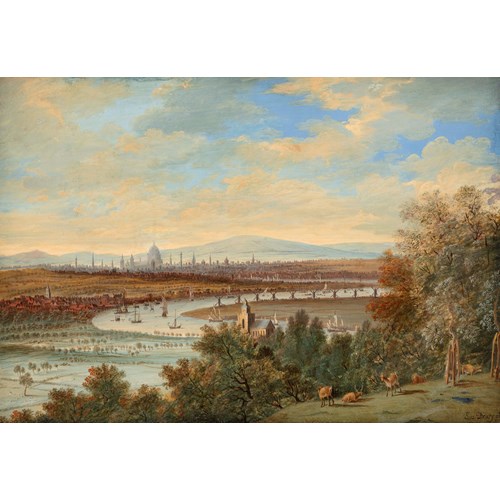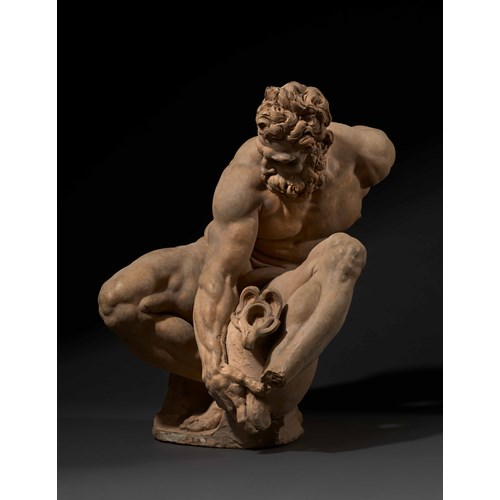Marketplace
Georg Raphael Donner
Georg Raphael Donner
Georg Raphael Donner
Date Circa 1730s
Medium Bronze
Dimension 23.5 x 31 cm (9¹/₄ x 12¹/₄ inches)
After the last supper, and before his arrest, Christ retired to the Mount of Olives to pray. It was here, as depicted in Donner’s plaquette, that Christ faced his spiritual struggle between the divine course of events, and the human instinct to be fearful of his imminent suffering. According to Luke, ‘there appeared to him an angel from heaven bringing him strength, and in anguish of spirit he prayed the more urgently’. Donner has created a plaque of theatricality and emotion, but balanced with proportion and poise. In the foreground we see Christ rendered in high relief, he is bent forward almost on the verge of collapse, supported by a tree trunk and an angel, who embraces him - wings spread wide and feet off the ground. Above, a cloud signifies the Angel’s divine direction, and God’s ultimate presence. In the background to the left we see the disciples, realised in low relief, sleeping beneath a tree. The lost wax cast is very fine and the surface has been carefully worked and finish, with a lovely rich brown patina.
Donner produced several bronze plaquettes like the present one during the 1730’s. These were often intended to be included in larger altarpiece commissions, as elements within a predella - such as his plaques which depict the same subject at Johannes Elemosynarius-Kapelle in Bratislava (figs. 1 and 2). The subject matter of the Agony of Christ was a popular theme in Baroque art and Donner’s sculptural interpretation can be compared with the painterly rendering of his compatriot Paul Troger (fig.3). The present relief can also be compared with two Pieta’s in the round, one dating to 1722 now in the National Gallery in Prague (fig. 4), and one of his last great masterpieces depicting the same subject in Gurk Cathedral, Carinthia, Austria, 1741 (fig.5).
Georg Raphael Donner, though best known as a sculptor, was also a talented architect, medallist and goldsmith. He was one of the most prolific Austrian sculptors of his generation and many German sculptors studied with him or were influenced by him, although his work remains relatively rare today.
Whilst mainly working in the Baroque style, his knowledge of and quotation from antiquity made him a unique artist. It was this knowledge of the classical world, as well as the refined elegant form and clear outline of his works which meant his sculpture contrasted against the prevailing Baroque exaggeration; and as such, his work marks an important transition from the Baroque toward the Neoclassical style.
Donner produced several bronze plaquettes like the present one during the 1730’s. These were often intended to be included in larger altarpiece commissions, as elements within a predella - such as his plaques which depict the same subject at Johannes Elemosynarius-Kapelle in Bratislava (figs. 1 and 2). The subject matter of the Agony of Christ was a popular theme in Baroque art and Donner’s sculptural interpretation can be compared with the painterly rendering of his compatriot Paul Troger (fig.3). The present relief can also be compared with two Pieta’s in the round, one dating to 1722 now in the National Gallery in Prague (fig. 4), and one of his last great masterpieces depicting the same subject in Gurk Cathedral, Carinthia, Austria, 1741 (fig.5).
Georg Raphael Donner, though best known as a sculptor, was also a talented architect, medallist and goldsmith. He was one of the most prolific Austrian sculptors of his generation and many German sculptors studied with him or were influenced by him, although his work remains relatively rare today.
Whilst mainly working in the Baroque style, his knowledge of and quotation from antiquity made him a unique artist. It was this knowledge of the classical world, as well as the refined elegant form and clear outline of his works which meant his sculpture contrasted against the prevailing Baroque exaggeration; and as such, his work marks an important transition from the Baroque toward the Neoclassical style.
Date: Circa 1730s
Medium: Bronze
Signature: Monogrammed lower right GRD
Dimension: 23.5 x 31 cm (9¹/₄ x 12¹/₄ inches)
More artworks from the Gallery









